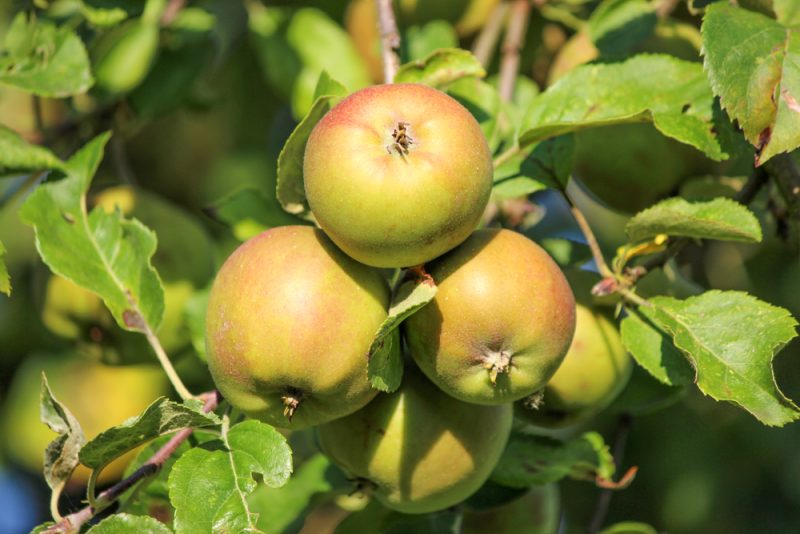Can Dogs Eat Crab Apples? Vet-Verified Nutrition Facts, Benefits & Risks
Click to Skip Ahead
Have you ever been out on a walk with your pup in the fall season and seen tiny apples littering the ground? Those are crab apples (Malus sylvestris), an older version of European cultivated apple species. These small apples are tarter than your everyday Honeycrisp or Granny Smith and are eaten less often than normal-sized apples.
If you and your pet have seen these, chances are good your dog has also tried to pick one up to taste or eat it. But are crab apples safe for dogs to eat? Many believe they’re toxic to canines, and while it’s true that these apples (particularly the seeds) contain traces of cyanogenic glycosides, or cyanide, small amounts of crab apples aren’t much of a risk to dogs.
That doesn’t mean you should let your dog feast on all the crab apple goodness they come across, though! Here’s what you should know about dogs and crab apples.




Why Can Dogs Eat Crab Apples?
Although crab apple seeds, leaves, and stems contain cyanogenic glycosides—specifically amygdalin, which converts to hydrogen cyanide after being consumed and metabolized—the crab apple fruit is generally okay for dogs. This is because the amount of cyanide within the seeds of these fruits is incredibly minute; a medium sized dog would need to eat around 3 oz of apple seeds and chew them up to suffer from toxicity, which equates to roughly 200 apples. It’s pretty safe to say a dog likely won’t consume enough crab apples for the cyanide to cause an issue, so this fruit is generally deemed non-toxic to canines.
Like many other non-dog-specific foods, though, moderation is key, as crab apples may upset sensitive stomachs. Dog owners should still be wary of the risks of dogs having access to large amounts of fallen crab apples, leaves and stems in the yard or on walks.


Benefits of Feeding Crab Apples to Dogs
Are there any nutritional benefits of feeding crab apples to your pup? Technically, crab apples have the same nutrients as regular apples but on a smaller scale. So, these tiny tart apples can offer your pet a bit of fiber, vitamin C, and even antioxidants. However, considering their size and the fact that a dog wouldn’t be eating a lot of them at a time, any nutritional benefits are negligible.
One plus of crab apples compared to regular apples is that this food has less sugar. This lack of sugar also doesn’t make these apples healthy for your canine companion, per se.
Risks of Feeding Crab Apples to Dogs
As we just mentioned, crab apples do have less sugar than regular apples but you still need to be mindful of the naturally occurring sugars they do contain. Any treat, including apples, should not make up more than 10% of your dog’s overall diet. This doesn’t mean your pup can’t have a crab apple or small bite of this (or another) fruit on occasion, but you should carefully monitor how much your pet consumes. Too much sugar in a dog’s diet can lead to weight gain, obesity, and other adverse health outcomes.
You also need to watch how many crab apples your dog eats at once. While it’s unlikely they’ll eat enough to suffer from cyanide poisoning, they could easily eat enough to upset their stomach. This is particularly true for pups with more sensitive stomachs, as just a few too many crab apples could cause them to suffer from a painful stomach ache or diarrhea.
Finally, you should be cautious with crab apples eaten off the ground because these fruits may be moldy, contaminated, or spoiled. After all, you have no idea how long they’ve been lying around! These things could make your pup severely ill, so check any fruit before letting your pet eat it.


What Happens if My Dog Eats Crab Apples?
If you find your pup snacking on a crab apple or two, there’s usually no need for concern and you can monitor them for any adverse effects. At least, not unless they’ve gone on a crab apple bender, but chances of that are slim. However, if you are concerned they’ve eaten a large amount of crab apples, or the leaves, branches and stems, call your vet, just to be safe.
In most cases of a dog eating a few too many crab apples, you’ll deal with a pup with a tummy upset. If you aren’t sure just how many crab apples your dog ate or if things seem off somehow, keep an eye out for any of the following:
- Tense, painful abdomen
- Lethargy
- Excessive diarrhea
- Blood in stool
- Excessive vomiting
- Blood in vomit
- Weakness
If you see any of these signs, you should get your pup to the vet right away!






Conclusion
While many believe crab apples are toxic to canines due to their trace amounts of cyanide, these tiny fruits are only poisonous if your dog consumes an overabundance of them (think hundreds). So, if you catch your dog snacking on a crab apple on your next walk, don’t panic! They should be fine. At most, your pup may suffer from an upset stomach and diarrhea.
However, crab apples aren’t necessarily the best snack for your four-legged friend. They should only ever be consumed in moderation, and the branches and leaves should be avoided. There’s also a risk of these fruits being contaminated or moldy if your pup eats them off the ground. Try to stick to dog-specific snacks for your pup instead.
Featured Image Credit: Mateusz Kropiwnicki, Shutterstock
